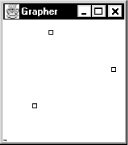Recipe 13.13 Program: Grapher
| Grapher is a simple program that reads a table of numbers and graphs them. The input format is two or more lines that each contain an X and a Y value. The output is an onscreen display that can also be printed. Figure 13-8 shows the results of running it with the following simple data; the first column is the X coordinate and the second is the Y coordinate of each point. The program scales the data to fit the window: 1.5 5 1.7 6 1.8 8 2.2 7 Figure 13-8. Grapher in action Example 13-8 shows the code. Example 13-8. Grapher.javaimport com.darwinsys.util.Debug; import java.awt.*; import java.awt.event.*; import javax.swing.*; import java.io.*; import java.util.*; /** Simple Graphing program. */ public class Grapher extends JPanel { /** Multiplier for range to allow room for a border */ public final static float BORDERFACTOR = 1.1f; /* Small inner class to hold x, y. Called Apoint to differentiate * from java.awt.Point. */ class Apoint { float x; float y; public String toString( ) { return "Apoint("+x+","+y+")"; } } /** The list of Apoint points. */ protected Vector data; /** The minimum and maximum X values */ protected float minx = Integer.MAX_VALUE, maxx = Integer.MIN_VALUE; /** The minimum and maximum Y values */ protected float miny = Integer.MAX_VALUE, maxy = Integer.MIN_VALUE; /** The number of data points */ protected int n; /** The range of X and Y values */ protected float xrange, yrange; public Grapher( ) { data = new Vector( ); } /** Read the data file named. Each line has an x and a y coordinate. */ public void read(String fname) { LineNumberReader is = null; try { is = new LineNumberReader(new FileReader(fname)); String txt; // Read the file a line at a time, parse it, save the data. while ((txt = is.readLine( )) != null) { StringTokenizer st = new StringTokenizer(txt); try { Apoint d = new Apoint( ); d.x = Float.parseFloat(st.nextToken( )); d.y = Float.parseFloat(st.nextToken( )); data.add(d); } catch(NumberFormatException nfe) { System.err.println("Invalid number on line " + is.getLineNumber( )); } } } catch (FileNotFoundException e) { System.err.println("File " + fname + " unreadable: " + e); } catch (IOException e) { System.err.println("I/O error on line " + is.getLineNumber( )); } n = data.size( ); if (n < 2) { System.err.println("Not enough data points!"); return; } // find min & max for (int i=0 ; i < n; i++) { Apoint d = (Apoint)data.elementAt(i); if (d.x < minx) minx = d.x; if (d.x > maxx) maxx = d.x; if (d.y < miny) miny = d.y; if (d.y > maxy) maxy = d.y; } // Compute ranges xrange = (maxx - minx) * BORDERFACTOR; yrange = (maxy - miny) * BORDERFACTOR; Debug.println("range", "minx,x,r = " + minx +' '+ maxx +' '+ xrange); Debug.println("range", "miny,y,r = " + miny +' '+ maxy +' '+ yrange); } /** Called when the window needs painting. * Computes X and Y range, scales. */ public void paintComponent(Graphics g) { super.paintComponent(g); Dimension s = getSize( ); if (n < 2) { g.drawString("Insufficient data", 10, 40); return; } // Compute scale factors float xfact = s.width / xrange; float yfact = s.height / yrange; // Scale and plot the data for (int i=0 ; i < n; i++) { Apoint d = (Apoint)data.elementAt(i); float x = (d.x-minx) * xfact; float y = (d.y-miny) * yfact; Debug.println("point", "AT " + i + " " + d + "; " + "x = " + x + "; y = " + y); // Draw a 5-pixel rectangle centered, so -2 both x and y. // AWT numbers Y from 0 down, so invert: g.drawRect(((int)x)-2, s.height-2-(int)y, 5, 5); } } public Dimension getPreferredSize( ) { return new Dimension(150, 150); } public static void main(String[] rgs) { final JFrame f = new JFrame("Grapher"); f.addWindowListener(new WindowAdapter( ) { public void windowClosing(WindowEvent e) { f.setVisible(false); f.dispose( ); System.exit(0); } }); Grapher g = new Grapher( ); f.setContentPane(g); f.setLocation(100, 100); f.pack( ); if (rgs.length == 0) g.read("Grapher.dat"); else g.read(rgs[0]); f.setVisible(true); } }Most of the complexity of Grapher lies in determining the range and scaling. You could obviously extend this to draw fancier drawings such as bar charts and the like. If pie charts interest you, see ChartBean in the online source. |
Java Cookbook, Second Edition
ISBN: 0596007019
EAN: 2147483647
EAN: 2147483647
Year: 2003
Pages: 409
Pages: 409
Authors: Ian F Darwin